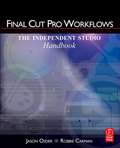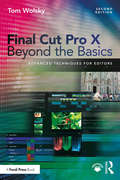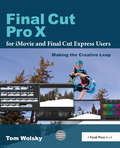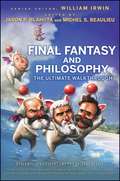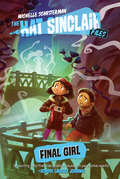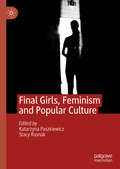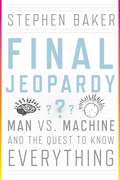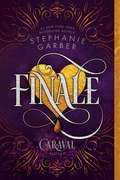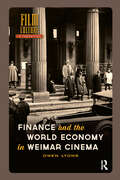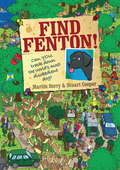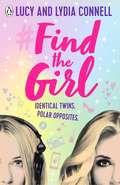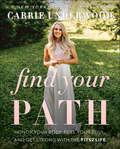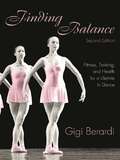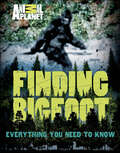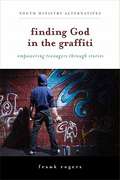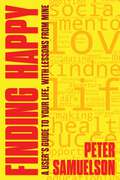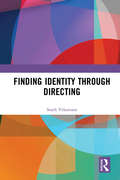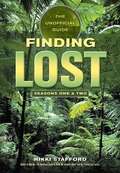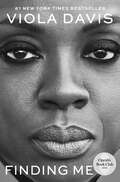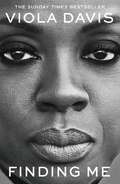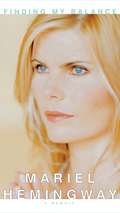- Table View
- List View
Final Cut Pro Workflows: The Independent Studio Handbook
by Robbie Carman Jason OsderToday's digital production tools empower the small team to produce multimedia projects that formerly required large teams. Orchestrating a production requires more than proficiency with the postproduction tools. Final Cut Pro Workflows: The Independent Studio Handbook offers a cookbook of postproduction workflows that teams can follow to deliver an array of products to their clients. It describes appropriate postproduction workflows, team roles and responsibilities, and required equipment for some of the most common media productions.Combining the wisdom of traditional roles and responsibilities with an understanding of how FCP facilitates a new flexibility where these roles/responsibilities can be redistributed, this book sheds light on workflow processes and responsibilities, and includes 7 real-world workflows from a diverse range of projects:* Money-Saving Digital Video Archive* Long-Form Documentary with Mixed Sources* Web-Based Viewing and Ordering System* 30-Second Spot for Broadcast* Multi-Part TV Series with Multiple Editors* DVD Educational Supplement* Music Video with Multi-Cam Editing and Multiple OutputsThe book also provides access to a companion website that features additional electronic chapters focusing on Final Cut Server, Apple's powerful new media asset management and workflow automation software. Written with a unique iconography to better convey key points and applicable to all levels of FCP users, Final Cut Pro Workflows: The Independent Studio Handbook is a vital reference tool for every postproduction house.
Final Cut Pro X Beyond the Basics: Advanced Techniques for Editors
by Tom WolskyGoing beyond where introductory books leave off and written for experienced editors, especially those new to Final Cut Pro X, this new and revised edition of Final Cut Pro X Beyond the Basics is brimming with cutting-edge methods to bring your editing skills to the next level. Explained in jargon-free language by a seasoned teacher and digital editor, Tom Wolsky’s text has been fully updated to address the new Final Cut Pro X 10.3 interface and changes to the software. This full-color workshop features tutorials that provide firsthand experience on the art and technique of editing at an advanced level with Final Cut Pro X, as well as in-depth information and time-saving tips that will allow you to master the application's interface elements, tools, and nuances. Wolsky covers all the bases, including: Library workflows and collaboration; Media organization and metadata customization for different genres; Editing techniques for projects of various lengths and types; Using markers and the timeline index; Audio tools; Multicam editing; Audio and video effects; Color correction, including secondary corrections and isolated color adjustments; Compositing and complex animation. An accompanying eResource features downloadable Final Cut Pro X project libraries for the tutorials discussed in the book, offering readers hands-on examples of the techniques and practices covered.
Final Cut Pro X for iMovie and Final Cut Express Users: Making the Creative Leap
by Tom WolskyUpdates and addendum for the new version of FCPX (10.0.3) are available on the companion website, fcpxbook.com.Are you an iMovie or Final Cut Express user ready to make the jump to Final Cut Pro? If so, look no further. Take your movies to the next level with this easy-to-follow, hand-on guide from one of the preeminent Apple trainers in the world today. Author Tom Wolsky starts with the basics of Final Cut Pro X, allowing you to easily make the leap from Final Cut Express or iMovie, then gradually introduces you to more complex techniques with step-by-step tutorials. Tom specifically shows you how certain techniques and concepts you utilized in iMovie and Final Cut Express translate to Final Cut Pro.More than a button-pushing manual, this editing workshop gives your firsthand experience with the art and technique of editing with Final Cut Pro. It includes in-depth information on the application's features, interface elements, and tools. You will develop a working knowledge of the principles and methods taught in film schools with tutorials that covers the essentials: . Nuances of system set-up to ensure smooth operation . Getting your tape-based and file-based AVCHD and DSLR media into Final Cut Pro and getting it organized . Editing to build and trim a sequence of shots. Working with audio, split edits, back-timing and level control . Adding transitions. Final Cut Pro titling tools. Color correction, image animation, and special effects . Compositing to enhance your projects . Outputting your material
Final Cut Studio On the Spot: The Independent Studio Handbook
by Richard Harrington Abba Shapiro Robbie CarmanPacked with more than 500 techniques, this book delivers what you need to know-on the spot. It is suited to editors of all experience levels, whether you are:* Migrating from another NLE* Upgrading to Final Cut Studio 2* Seeking a handy reference to raise your proficiencyNo need to wade through tomes of documentation. Final Cut Studio On the Spot presents immediate solutions in an accessible format. Step-by-step instruction by Apple Certified Pros shows you how to:* Optimize system performance* Create impressive titles with Generators, Motion, LiveType, and Photoshop* Build Commercial-quality transitions* Work quickly with buttons and keyboard shortcuts* Color correct to save vital shots, and keep them broadcast legal* Fix and mix for professional-quality audio* Use the compositing tools of master editors* Design and import graphics seamlessly* Integrate with other applications including Motion, Soundtrack Pro and Color* Troubleshoot and recover files* Manage media and backup strategies* Export and publish finished projects to tape, DVD, or the Web
Final Cut: Dreams and Disaster in the Making of Heaven's Gate
by Steven BachThe book is about the creation of the film 'Heavens Gate'. It reflects a very unusual image of film making - the behind-the-scenes stories about difficulties, both financial and physical.
Final Fantasy and Philosophy: The Ultimate Walkthrough
by P. Blahuta Michel S. BeaulieuEverything you need to achieve a greater understanding of Final Fantasy and transform your status is here: the Basic Controls, Playing the Game, Abilities, Side Quests, and Other Ways to Enjoy the Game. Mages, Moogles, Fiends, and Kefka, however, have been mashed together with the likes of Machiavelli, Marx, Foucault, and Kafka. The result, we hope, will launch you into your own philosophical quests of Final Fantasy and beyond. And, of course, your intellectual status will be forever changed on reading this book.
Final Girl #3
by Michelle Schusterman Stephanie OleshTeenage ghostbuster Kat is back, but this time, traveling halfway around the world might not be far away enough to escape from whatever is haunting her! As Passport to Paranormal sets off for Beijing and Seoul, Kat is ready to take her ghostbusting abroad. She hasn't seen the Thing since Argentina, but weird things have been happening ever since. Kat's handwriting is appearing in strange places and the film crew on P2P gets footage of two Kats. Mi Jin has a theory: it's a doppelganger. But Kat needs a solution, and fast, because whatever the Thing has become, it's lashing out at the people Kat cares about most. And what did the Thing mean when she promised Kat's mother that the old Kat would soon be gone, and the new Kat would come home... forever?
Final Girls, Feminism and Popular Culture
by Katarzyna Paszkiewicz Stacy RusnakThis volume examines contemporary reformulations of the ‘Final Girl’ in film, TV, literature and comic, expanding the discussion of the trope beyond the slasher subgenre. Focusing specifically on popular texts that emerged in the 21st century, the volume asks: What is the sociocultural context that facilitated the remarkable proliferation of the Final Girls? What kinds of stories are told in these narratives and can they help us make sense of feminism? What are the roles of literature and media in the reconsiderations of Carol J. Clover’s term of thirty years ago and how does this term continue to inform our understanding of popular culture? The contributors to this collection take up these concerns from diverse perspectives and with different answers, notably spanning theories of genre, posthumanism, gender, sexuality and race, as well as audience reception and spectatorship.
Final Jeopardy: Man vs. Machine and the Quest to Know Everything
by Stephen BakerTechnology journalist Baker reveals the story behind Watson, the IBM computer designed specifically to compete in the television quiz show Jeopardy! against some of the show's greatest champions. The nature of the show, with puns and other forms of wordplay complicating the task of recalling the wide range of knowledge prompted by Jeopardy!'s "answers," posed a significant challenge in artificial intelligence design, in some ways a far more subtle challenge than that faced by IBM's chess-playing computer, Deep Blue. Baker discusses the people behind the program, the origins and progress of the program, the computing and artificial intelligence issues raised, and related topics. (Following publication, Watson handily trounced former Jeopardy! champions Ken Jennings and Brad Rutter in the televised challenge. ) Annotation ©2011 Book News, Inc. , Portland, OR (booknews. com)
Finale: A Caraval Novel (Caraval #3)
by Stephanie GarberWelcome, welcome to Finale, the third and final book in Stephanie Garber’s #1 New York Times bestselling Caraval series! A love worth fighting for. A dream worth dying for. An ending worth waiting for.It’s been two months since the Fates were freed from a deck of cards, two months since Legend claimed the throne for his own, and two months since Tella discovered the boy she fell in love with doesn’t really exist.With lives, empires, and hearts hanging in the balance, Tella must decide if she’s going to trust Legend or a former enemy. After uncovering a secret that upends her life, Scarlett will need to do the impossible. And Legend has a choice to make that will forever change and define him.Caraval is over, but perhaps the greatest game of all has begun. There are no spectators this time: only those who will win, and those who will lose everything.Welcome, welcome to Finale. All games must come to an end…
Finance and the World Economy in Weimar Cinema (Film Culture in Transition)
by Owen LyonsAfter the First World War, the effects of financial crisis could be felt in all corners of the newly formed Weimar Republic. The newly interconnected world economy was barely understood and yet it was increasingly made visible in the films of the time. The complexities of this system were reflected on screen to both the everyday spectator as well as a new class of financial workers who looked to popular depictions of speculation and crisis to make sense of their own place on the shifting ground of modern life. Finance and the World Economy in Weimar Cinema turns to the many underexamined depictions of finance capital that appear in the films of 1920s Germany. The representation of finance capital in these films is essential to our understanding of the culture of the Weimar Republic – particularly in the relation between finance and ideas of gender, nation and modernity. As visual records, these films reveal the stock exchange as a key space of modernity and coincide with the abstraction of finance as a vast labour of representation in its own right. In so doing, they introduce core visual tropes that have become essential to our understanding of finance and capitalism throughout the twentieth century.
Find Fenton!
by Stuart Cooper'Fenton... FENTON! Oh, Jesus Christ!' Meet Fenton, the world's most famous dog. Not content with the deer-chasing rampage that propelled him into the limelight, the world's naughtiest Labrador is off on a whirlwind tour of destruction across London. Starting where it all began in Richmond Park, this hilarious book challenges you to find Fenton in a variety of famous locations, from the Royal Albert Hall to the House of Commons, from the Tate Modern to St Pancras Station. Wherever he goes, Fenton leaves a trail of chaos; wrecking a garden party at Buckingham Palace, pestering the players at Wimbledon and upstaging the celebrities at a Leicester Square film premiere. With clues to help you on your way, follow the leads and collar Fenton before he escapes for good...
Find Fenton!
by Stuart Cooper'Fenton... FENTON! Oh, Jesus Christ!' Meet Fenton, the world's most famous dog. Not content with the deer-chasing rampage that propelled him into the limelight, the world's naughtiest Labrador is off on a whirlwind tour of destruction across London. Starting where it all began in Richmond Park, this hilarious book challenges you to find Fenton in a variety of famous locations, from the Royal Albert Hall to the House of Commons, from the Tate Modern to St Pancras Station. Wherever he goes, Fenton leaves a trail of chaos; wrecking a garden party at Buckingham Palace, pestering the players at Wimbledon and upstaging the celebrities at a Leicester Square film premiere. With clues to help you on your way, follow the leads and collar Fenton before he escapes for good...
Find The Girl
by Lucy Connell Lydia ConnellThe perfect summer read for fans of Girl Online and Rainbow Rowell! ----- Falling for your best friend's love interest is bad...Falling for your twin's is catastrophic.As kids, Nina and Nancy were inseparable. As teenagers, not so much...Where Nancy is popular, an Instagram star, and obsessed with boy band heartthrob Chase, Nina is shy; a talented classical musician, and shuns the spotlight that her sister thrives in.But when the wrong twin unwittingly ends up at the centre of a romantic social media storm, the bonds of twin-ship will be tested like never before... Written in collaboration with Katy Birchall, #FINDTHEGIRL is a very modern twist on a Cinderella story.
Find Your Path: Honor Your Body, Fuel Your Soul, and Get Strong with the Fit52 Life
by Carrie UnderwoodCarrie Underwood's instant New York Times bestseller on honoring your body, fueling your soul, and getting strong—a great gift idea for fans of fitness and the megastar country singer."I want to be healthy and fit 52 weeks of the year, but that doesn't mean I have to be perfect every day. This philosophy is a year-round common-sense approach to health and fitness that involves doing your best most of the time—and by that I don't mean being naughty for three days and good for four. I mean doing your absolute best most of the time during every week, 52 weeks of the year."—Carrie UnderwoodCarrie Underwood believes that fitness is a lifelong journey. She wasn’t born with the toned arms and strong legs that fans know her for. Like all of us, she has to work hard every day to look the way that she does! In FIND YOUR PATH she shares her secrets with readers, with the ultimate goal of being the strongest version of themselves, and looking as good as they feel. Carrie’s book will share secrets for fitting diet and exercise into a packed routine—she’s not only a multi-Platinum singer, she’s a businesswoman and busy mom with two young children. Based on her own active lifestyle, diet, and workouts, FIND YOUR PATH is packed with meal plans, recipes, weekly workout programs, and guidelines for keeping a weekly food and workout journal. It also introduces readers to Carrie's signature Fit52 workout, which involves a deck of cards and exercises that can be done at home—and it sets her fans on a path to sustainable health and fitness for life. Fit52 begins with embracing the "Pleasure Principle" in eating, making healthy swaps in your favorite recipes, and embracing a long view approach to health—so that a cheat a day won't derail you.Throughout the book, Carrie shares her personal journey towards optimal health, from her passion for sports as a kid, to the pressure to look perfect and fit the mold as she launched her career after winning American Idol, to eventually discovering the importance of balance and the meaning of true health. For Carrie, being fit isn't about crash diets or a workout routine that you're going to dread. It’s about healthy choices and simple meals that you can put together from the ingredients in your local grocery store, and making the time, every day, to move, to love your body, and to be the best version of yourself.
Finding Balance: Fitness, Training, and Health for a Lifetime in Dance
by Gigi BerardiFinding Balance: Fitness, Health, and Training for a Lifetime in Dance gives an overview of issues faced by all performing dancers: injury and treatment; technique and training; fitness; nutrition and diet; and career management. The text includes both easy-to-read overviews of each topic and "profiles" of well known dancers and how they have coped with these issues. The new edition includes: Updated and new profiles. Expanded injury and injury treatment information. Updated dance science and physiology findings, and new references. Updated diet guidelines, Expanded and updated "Taking Control" section. It concludes with a list of selected dance/arts medicine clinics, a bibliography, glossary, and text notes.
Finding Bigfoot: Everything You Need to Know
by Animal PlanetA howl in the distance. The biggest footprint you've ever seen. A blurry figure in the distance. These are the clues that lead us to believe there is something out there—Bigfoot. Already a fan of the wildly successful FINDING BIGFOOT television show on Animal Planet? (One of the top-performing TV shows in the network's history!) Stacked with information for your burning Sasquatch questions, this heavily illustrated work features a compelling narrative with commentary from the stars of the show, photographs and extras from the Animal Planet's archives, and so much more. Skeptics will be given all the information they need to decide for themselves if they believe, and enthusiasts will revel in this essential Bigfoot book.Do you hear that howl? Bigfoot is calling.
Finding God in the Graffiti: Empowering Teenagers Through Stories
by Frank Rogers Jr.Finding God in the Graffiti encourages church educators, youth ministers, and students of ministry to connect the living reality of God through the use of powerful stories and narratives that will engage the youth in their church or Christian organization. It will inspire readers with many ways in which stories can engage youth educationally; provides a conceptual map of discipline for teaching and learning purposes; equips youth workers to practice a repertoire of narrative methods with young people; and gives practitioners conceptual tools to reflect on their practice with insight and precision.
Finding Happy: A User's Guide to Your Life, with Lessons from Mine
by Peter SamuelsonA master class for every Gen Z and Millennial to Find Happy in a dizzying worldAlmost everyone looks back on their youth and thinks, &“I wish I knew then what I know now.…&” This is a book for young adults who want to know right now what it is so many wish they had known back then. What is happy, anyway? Where do you find it? Finding Happy is for young adults starting their adult journey, and for those well into theirs who have not yet sighted land. It is written by a master storyteller who learned to scale walls and blew them up rather than be stopped, and who learned in the process that our happiness flows from leaving the world a better place than we found it. Ultimately, it&’s about how best to channel this glorious life we are each privileged to enjoy and to make it truly happy. Finding Happy is filled with gripping adventures and misadventures that demonstrate just how possible the seemingly impossible often is, from daredevil filmmaking in Africa and Asia to making daunting rules work for you, to earning a full college scholarship after being completely unable to answer the entrance exam essay question…to climbing down a hundred-foot pipe shaft at 3 a.m. to rescue a kitten, with no plan for how to climb back up. It is about how best to seize the day, which risks are brave and which foolish, about roadblocks and solutions, learning from leaders and finding your own secret sauce. Samuelson explains how to find your compass and persuade others to help you. He shows how to live your passion, make a living, take off your mask, build your best place in the universe, and find your own unique and personal Happy.
Finding Identity Through Directing
by Soseh YekaniansFinding Identity through Directing is a practice-led autoethnographical monograph that provides an in-depth exploration into the field of theatre directing and an individual’s endless creative pursuit for belonging. The book specifically examines how a culturally displaced individual may find a sense of identity through their directing and addresses the internal struggles of belonging, acceptance and Self that are often experienced by those who have confronted cultural unhoming. The first half of the story scrutinises Dr Yekanians’ own identity as an Iranian born Armenian-Australian and how she struggled with belonging growing up in a world that for the most part, was unaccepting of her differences. The second half, looks at how theatre directing, aided her (re)discovery of Self. While evidence shows that within the past decade there has been a growing interest in the vocation of theatre directing, embarking on a career within this field, while exciting, can often be a daunting and experimental vocation. Finding Identity through Directing questions this conundrum and specifically asks, in a competitive artistic profession that is rapidly developing, what attracts an individual to the authoritative role of the director and what are the underlying motivations of this attraction? By uncovering that there is more to the role of the director than the mere finality of a production, we can observe that the theatre is a promising setting for cultural exchanges in dialogue and for personal development. Theatre directing as the vehicle for these expansions and progressions of self can potentially address the internal struggles of identity often experienced by those who, in some form, have encountered cultural displacement.
Finding Lost: The Unofficial Guide
by Nikki StaffordIf you're feeling as lost as the castaways on the show, Finding Lost is the crucial companion guide to help you unravel the mysteries of the island. This is the only book that offers an episode-by-episode guide to the first two seasons of the show, following the developments of the characters, the plots, and the various connections fans must make to keep up. Finding Lost includes: an in-depth look at every episode, with highlights, music, and nitpicks outlined at the end of each one, chapters on the real John Locke and Jean-Jacques Rousseau (and how they compare to the fictional ones), fan conspiracy theories, the blast door map, the Dharma symbol, and B.F. Skinner, sidebars chronicling fun trivia such as Sawyer's nicknames for people; what Hurley's numbers could mean; Vincent's mysterious appearances and disappearances; the redemption of the characters, bios of all of the major actors on the show, summaries of the show's literary references, including Lord of the Flies, The Third Policeman, Our Mutual Friend, Watership Down, and many more, photos of the filming locations in Hawaii, including a detailed map to allow you to conduct your own tour when in Oahu. Full of exclusive photos and enough background to put you leagues ahead of other viewers, this book will finally help you "find" Lost.
Finding Me: A Memoir
by Viola DavisIn my book, you will meet a little girl named Viola who ran from her past until she made a life-changing decision to stop running forever. <p><p>This is my story, from a crumbling apartment in Central Falls, Rhode Island, to the stage in New York City, and beyond. This is the path I took to finding my purpose but also my voice in a world that didn’t always see me.As I wrote Finding Me, my eyes were open to the truth of how our stories are often not given close examination. We are forced to reinvent them to fit into a crazy, competitive, judgmental world. So I wrote this for anyone running through life untethered, desperate and clawing their way through murky memories, trying to get to some form of self-love. <p><p>For anyone who needs reminding that a life worth living can only be born from radical honesty and the courage to shed facades and be . . . you. Finding Me is a deep reflection, a promise, and a love letter of sorts to self. My hope is that my story will inspire you to light up your own life with creative expression and rediscover who you were before the world put a label on you. <p> <b>New York Times Bestseller</b>
Finding Me: A Memoir - AS SEEN ON NETFLIX ON OPRAH + VIOLA
by Viola DavisTHE DEEPLY PERSONAL, BRUTALLY HONEST ACCOUNT OF VIOLA'S INSPIRING LIFEIn my book, you will meet a little girl named Viola who ran from her past until she made a life changing decision to stop running forever.This is my story, from a crumbling apartment in Central Falls, Rhode Island, to the stage in New York City, and beyond. This is the path I took to finding my purpose and my strength, but also to finding my voice in a world that didn't always see me.As I wrote Finding Me, my eyes were open to the truth of how our stories are often not given close examination. They are bogarted, reinvented to fit into a crazy, competitive, judgmental world. So I wrote this for anyone who is searching for a way to understand and overcome a complicated past, let go of shame, and find acceptance. For anyone who needs reminding that a life worth living can only be born from radical honesty and the courage to shed facades and be...you.Finding Me is a deep reflection on my past and a promise for my future. My hope is that my story will inspire you to light up your own life with creative expression and rediscover who you were before the world put a label on you.
Finding My Balance: A Memoir
by Mariel HemingwayActress Mariel Hemingway uses the lessons and practices of yoga as a starting point for her own personal reflections and a larger-than-life family story. The result is a searingly honest memoir that is firmly practical, as well as a moving narrative of the author's struggle to deal with a complex and often stressful life. Mariel was the third daughter born to Jack Hemingway, Ernest Hemingway's son, and Byra Whittlesey. Her older sister, Muffet, suffered for years from instability, while middle sister Margaux, a celebrated actress and model who was caught up in the fast lane, eventually died of the effects of her driven lifestyle. Their mother, Byra, was darkly moody and emotionally quixotic, and made no secret of her disdain for her husband, while Jack, himself insecure in no small part because of his celebrated father, a man he never really felt he knew, was an indifferent parent at best. Even before she was a teenager, Mariel was forced to assume the role of stable center of her family. In just about every way, she never really had a childhood of her own, a situation that was exacerbated by her sudden thrust into celebrity when she was first cast in sister Margaux's film Lipstick, then in Woody Allen's Manhattan. Suddenly, Mariel was a movie star. Always an athletic person, Mariel turned to yoga and its meditative practice in an effort to maintain her center while much of her life threatened to spin out of control. As the title of this remarkable memoir suggests, much of her adult life has been directed toward finding and maintaining her balance in situations that have been heartbreakingly unsettling and emotionally disorienting. Throughout the book, Mariel uses her yoga training as a starting point for each chapter, carefully describing a particular position, then letting her mind wander into thoughts of the past and her rocky life. As each chapter begins with instruction, so does the book end in the same way, the exercises this time organized in a sequence that can be followed by anyone who wants to practice them. Included are photos of Mariel as she performs the various moves. Living the life now of wife and mother to two teenaged daughters while still pursuing a career in film, Mariel Hemingway has weathered some of the worst storms that life can bring. Certainly she has found her balance. And in this deeply inspiring, thoroughly fascinating memoir, she shares for the first time the story of that journey.
Finding My Bella Vita: A story of family, food, fame and working out who you are
by Pia MirandaFor years Pia Miranda has been stopped in the street by calls of, 'Found you!', forever linked to that character we all loved: Josie from Looking for Alibrandi. But playing Josie is only one small part of everything that has shaped the woman Pia has become.As a child, her Nonna would tell her stories of the small volcanic island off Sicily she called home. Cannoli, curses and lighting a candle at church were as much a part of Pia's childhood as mouse plagues, her Aussie Nanna's lemon slice and cheering on South Melbourne at the footy with her Grandfather.After chasing a childhood dream to become a ballet dancer (with a back-up plan of becoming a nun) she was cruelly shamed out of her leotard and into a new dream: acting. The rollercoaster ride of fame would see her travel the world and narrowly avoid a sky-high #MeToo moment. But after fame comes real life - work stress, career questions, money worries, relationships and heartbreak, love and marriage, illness and grief. Having grown up pinballing between her very Italian side and her very Australian side while trying to carve out a space all her own, Pia didn't realise how the push and pull of tradition had made her world all the richer.Finally, setting foot on Vulcano to reconnect with her roots, Pia understands how all the parts of herself have made her the true survivor she is. Like her Nonna told her, every day on top of the earth is a good day. Finding My Bella Vita is a charming, honest and uplifting memoir full of heart and humour that reminds us all of the two things that matter most - love and family. (A good cannoli and some Vegemite toast also rate pretty highly!)'Like a long phone call with a friend . . . an intimate monologue from a talented storyteller with a self-deprecating and light touch' BOOKS+PUBLISHING
